Risk of Myeloma Still Small Despite Newly Revealed Gene Mutations

In the largest study to date, researchers from The Institute of Cancer Research in London identified eight new gene mutations increasing the risk of developing myeloma — a risk that is still very small, according to experts.
The study, “Genome-wide association study identifies multiple susceptibility loci for multiple myeloma,” published in the journal Nature Communications, provides more evidence of a notion doctors have long suspected — that myeloma can run in families.
Using a technique known as genome wide association study (GWAS), tracking single base pair mutations across the entire genome in both patients and healthy people, researchers can find genes linked to a disease without having any theory of what to look for. The method, however, requires large groups of people to get robust results, and so the study included 9,866 myeloma patients and 239,188 healthy volunteers.
The eight mutations identified by the research team were found in DNA regions important for the control of genes researchers know contribute to myeloma disease processes, such as production of antibodies.
The team estimated that that mutations linked to myeloma so far cover only about 20 percent heritable myeloma genes, and more studies are planned to map additional factors.
In a news release, senior author Prof. Richard Houlston explained that although the study deepens the knowledge of how genes can affect myeloma risk, the task is far from completed.
“We know that the inherited risk of myeloma does not come from just one or two major risk genes, as can be the case with breast cancer, but from multiple different genetic variants, each with only a small individual effect on risk,” Houlston said. “Identifying more of these variants gives us new insights into the potential causes of the disease, and opens up new strategies for prevention.”
Eric Low, chief executive at Myeloma UK, who funded the study along with Bloodwise, cautioned that even though it advances our understanding of the disease, people should not be alarmed by the possibility of carrying risks genes.
“It is important to note, however, that myeloma accounts for only 2 percent of all cancers, so while this research takes an extremely important look at the familial risk of developing myeloma, the overall risk to the general populace of developing myeloma is small,” said Low.
His statement was supported by Dr. Alasdair Rankin, research director at Bloodwise.
“These findings give an insight into the genetic and biological basis of why myeloma can occasionally run in families. It is important to remember that while relatives of patients may have a higher risk of developing myeloma than the rest of the population, their absolute risk is still low,” Rankin said.
“Further studies could help guide the development of new drugs to treat this cancer in the future. With a more complete genetic picture, it may even be possible to identify those family members at an increased risk and find ways to prevent them from developing myeloma,” he said.






